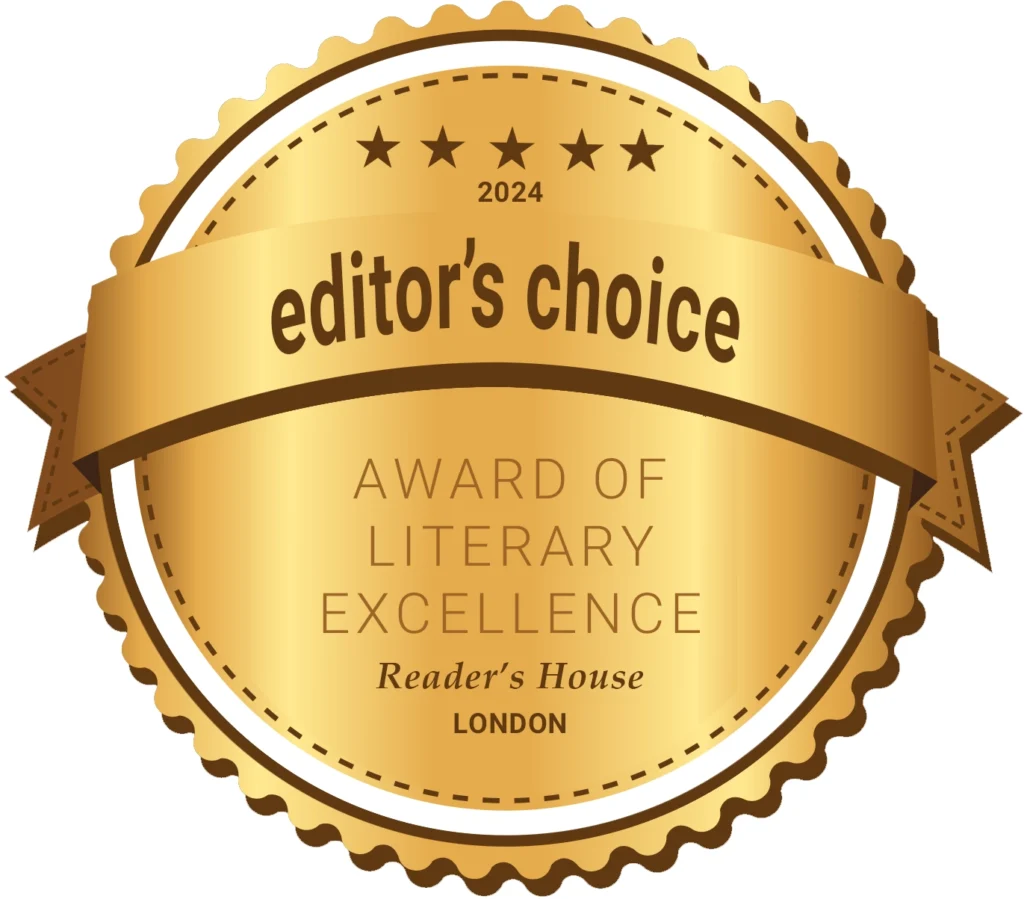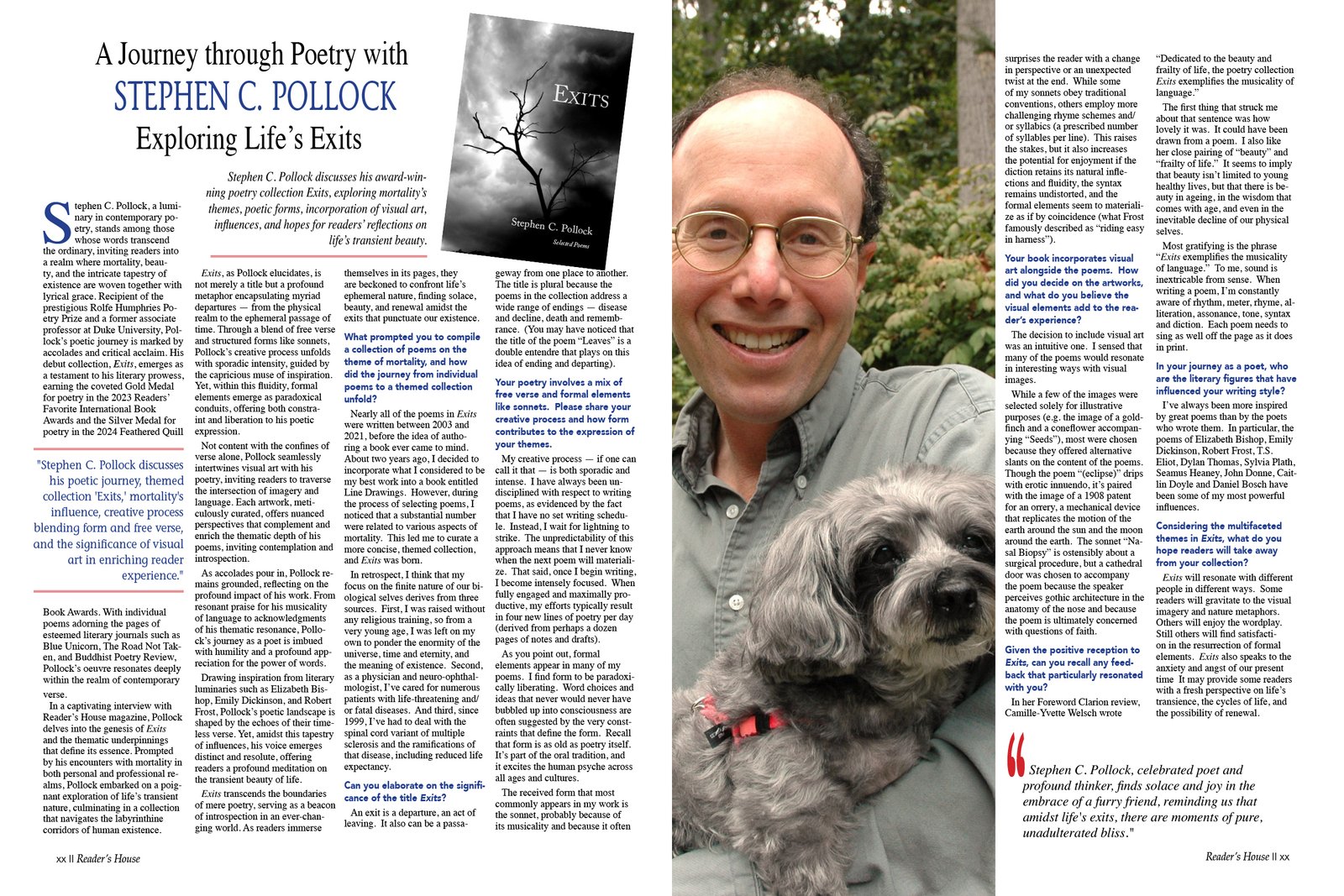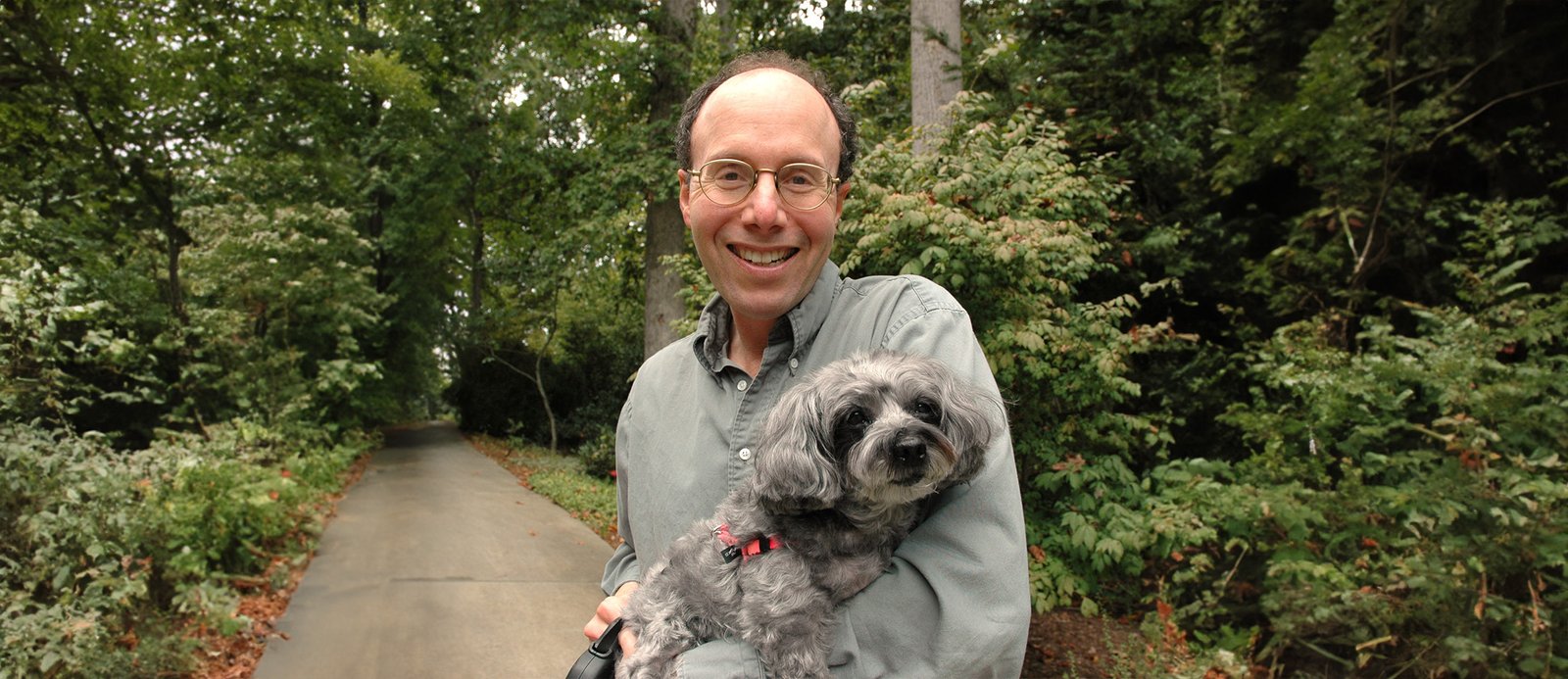Stephen C. Pollock discusses his award-winning poetry collection Exits, exploring mortality’s themes, poetic forms, incorporation of visual art, influences, and hopes for readers’ reflections on life’s transient beauty.
Stephen C. Pollock, a creative force in contemporary poetry, stands among those whose words transcend the ordinary, inviting readers into a realm where mortality, beauty, and the intricate tapestry of existence are woven together with lyrical grace. Recipient of the Rolfe Humphries Poetry Prize and a former associate professor at Duke University, Pollock’s poetic journey is marked by accolades and critical acclaim. His debut collection, Exits, is a testament to his literary prowess, earning the coveted Gold Medal for poetry in the 2023 Readers’ Favorite International Book Awards and the Silver Medal for poetry in the 2024 Feathered Quill Book Awards. With individual poems adorning the pages of esteemed literary journals such as Blue Unicorn, The Road Not Taken, and Live Canon Anthology, Pollock’s oeuvre resonates deeply within the realm of contemporary verse.
In a captivating interview with Reader’s House magazine, Pollock delves into the genesis of Exits and the thematic underpinnings that define its essence. Prompted by his encounters with mortality in both personal and professional realms, Pollock embarked on a poignant exploration of life’s transient nature, culminating in a collection that navigates the labyrinthine corridors of human existence.
Exits, as Pollock elucidates, is not merely a title but a profound metaphor encapsulating myriad departures — from the physical realm to the ephemeral passage of time. Through a blend of free verse and structured forms like sonnets, Pollock’s creative process unfolds with both lyricism and intensity, guided by the capricious muse of inspiration. Yet, within this fluidity, formal elements emerge as paradoxical conduits, offering both constraint and liberation to his poetic expression.
Not content with the confines of verse alone, Pollock seamlessly intertwines visual art with his poetry, inviting readers to traverse the intersection of imagery and language. Each artwork, meticulously curated, offers nuanced perspectives that complement and enrich the thematic depth of his poems, inviting contemplation and introspection.
As accolades accrue in, Pollock remains grounded, reflecting on the profound impact of his work. From resonant praise for his musicality of language to acknowledgments of his thematic resonance, Pollock’s journey as a poet is imbued with humility and a profound appreciation for the power of words.
Drawing inspiration from literary luminaries such as Elizabeth Bishop, Emily Dickinson, and Robert Frost, Pollock’s poetic landscape is shaped by the echoes of their timeless verse. Yet, amidst this tapestry of influences, his voice emerges distinct and resolute, offering readers a profound meditation on the transient beauty of life.
Exits transcends the boundaries of mere poetry, serving as a beacon of introspection in an ever-changing world. As readers immerse themselves in its pages, they are beckoned to confront life’s ephemeral nature, finding solace, beauty, and renewal amidst the exits that punctuate our existence.
What prompted you to compile a collection of poems on the theme of mortality, and how did the journey from individual poems to a themed collection unfold?
Nearly all of the poems in Exits were written between 2003 and 2021, before the idea of authoring a book ever came to mind. About two years ago, I decided to incorporate what I considered to be my best work into a book entitled Line Drawings. However, during the process of selecting poems, I noticed that a substantial number were related to various aspects of mortality. This led me to curate a more concise, themed collection, and Exits was born.
In retrospect, I think that my focus on the finite nature of our biological selves derives from three sources. First, I was raised without any religious training, so from a very young age, I was left on my own to ponder the enormity of the universe, time and eternity, and the meaning of existence. Second, as a physician and neuro-ophthalmologist, I’ve cared for numerous patients with life-threatening and/or fatal diseases. And third, since 1999, I’ve had to deal with the spinal cord variant of multiple sclerosis and the ramifications of that disease, including reduced life expectancy.
Can you elaborate on the significance of the title Exits?
An exit is a departure, an act of leaving. It also can be a passageway from one place to another. The title is plural because the poems in the collection address a wide range of endings — disease and decline, death and remembrance. (You may have noticed that the title of the poem “Leaves” is a double entendre that plays on this idea of ending and departing).
Your poetry involves a mix of free verse and formal elements like sonnets. Please share your creative process and how form contributes to the expression of your themes.
My creative process — if one can call it that — is both sporadic and intense. I have always been undisciplined with respect to writing poems, as evidenced by the fact that I have no set writing schedule. Instead, I wait for lightning to strike. The unpredictability of this approach means that I never know when the next poem will materialize. That said, once I begin writing, I become intensely focused. When fully engaged and maximally productive, my efforts typically result in four new lines of poetry per day (derived from perhaps a dozen pages of notes and drafts).
As you point out, formal elements appear in many of my poems. I find form to be paradoxically liberating. Word choices and ideas that never would never have bubbled up into consciousness are often suggested by the very constraints that define the form. Recall that form is as old as poetry itself. It’s part of the oral tradition, and it excites the human psyche across all ages and cultures.
The received form that most commonly appears in my work is the sonnet, probably because of its musicality and because it often surprises the reader with a change in perspective or an unexpected twist at the end. While some of my sonnets obey traditional conventions, others employ more challenging rhyme schemes and/or syllabics (a prescribed number of syllables per line). This raises the stakes, but it also increases the potential for enjoyment if the diction retains its natural inflections and fluidity, the syntax remains undistorted, and the formal elements seem to materialize as if by coincidence (what Frost famously described as “riding easy in harness”).
Your book incorporates visual art alongside the poems. How did you decide on the artworks, and what do you believe the visual elements add to the reader’s experience?
The decision to include visual art was an intuitive one. I sensed that many of the poems would resonate in interesting ways with visual images.
While a few of the images were selected solely for illustrative purposes (e.g. the image of a goldfinch and a coneflower accompanying “Seeds”), most were chosen because they offered alternative slants on the content of the poems. Though the poem “(eclipse)” drips with erotic innuendo, it’s paired with the image of a 1908 patent for an orrery, a mechanical device that replicates the motion of the earth around the sun and the moon around the earth. The sonnet “Nasal Biopsy” is ostensibly about a surgical procedure, but a cathedral door was chosen to accompany the poem because the speaker perceives gothic architecture in the anatomy of the nose and because the poem is ultimately concerned with questions of faith.
Given the positive reception to Exits, can you recall any feedback that particularly resonated with you?
In her Foreword Clarion review, Camille-Yvette Welsch wrote “Dedicated to the beauty and frailty of life, the poetry collection Exits exemplifies the musicality of language.”
The first thing that struck me about that sentence was how lovely it was. It could have been drawn from a poem. I also like her close pairing of “beauty” and “frailty of life.” It seems to imply that beauty isn’t limited to young healthy lives, but that there is beauty in ageing, in the wisdom that comes with age, and even in the inevitable decline of our physical selves.
Most gratifying is the phrase “Exits exemplifies the musicality of language.” To me, sound is inextricable from sense. When writing a poem, I’m constantly aware of rhythm, meter, rhyme, alliteration, assonance, tone, syntax and diction. Each poem needs to sing as well off the page as it does in print.
In your journey as a poet, who are the literary figures that have influenced your writing style?
I’ve always been more inspired by great poems than by the poets who wrote them. In particular, the poems of Elizabeth Bishop, Emily Dickinson, Robert Frost, T.S. Eliot, Dylan Thomas, Sylvia Plath, Seamus Heaney, John Donne, Caitlin Doyle and Daniel Bosch have been some of my most powerful influences.
Considering the multifaceted themes in Exits, what do you hope readers will take away from your collection?
Exits will resonate with different people in different ways. Some readers will gravitate to the visual imagery and nature metaphors. Others will enjoy the wordplay. Still others will find satisfaction in the resurrection of formal elements. Exits also speaks to the anxiety and angst of our present time It may provide some readers with a fresh perspective on life’s transience, the cycles of life, and the possibility of renewal.
EDITOR’S CHOICE
EXITS
Exits, a masterful fusion of poetic brilliance and profound introspection, captures life’s essence with evocative verses and captivating imagery.
Exits, penned by Stephen C. Pollock, is a poignant exploration of life’s ephemerality, resonating with the essence of mortality and the potential for renewal. Drawing upon nature’s imagery and metaphors, Pollock weaves a tapestry of verses that delve deep into the human experience.





